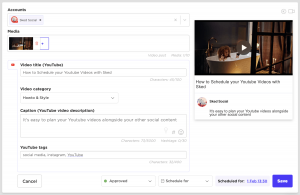The field of marketers shooting for the next Oreo moment is crowded, so we asked the experts how best to prepare real-time marketing plans for the big game.

The lights going out during halftime of the 2013 Super Bowl was unexpected, but even more surprising was how one quickly composed tweet from Oreo changed the face of social media marketing around the Super Bowl forever.
These days brands searching for their own Oreo moment are going all in to prepare their Super Bowl social efforts, building out war rooms, staffing up and brainstorming to make sure they are ready to take advantage of the year’s biggest marketing prize.
Oreo’s success — its “You can still dunk in the dark” tweet was retweeted more than 15,000 times — was a watershed for brands, showing the potential for instant social victories and prompting a flood into the real-time marketing zone for the 2014 Super Bowl.
Power out? No problem. pic.twitter.com/dnQ7pOgC
— Oreo Cookie (@Oreo) February 4, 2013
Last year, 29 of the Interbrand top 100 brands made a real-time effort during the Super Bowl, more than three times as many as 2013. That doesn’t include the usual RTM players — such as Denny’s, DiGiorno Pizza, Charmin, JCPenney and Arby’s — and scores of other companies who can be counted on for social commentary during major live events.
The Super Bowl RTM field is likely to be even more crowded this year when the New England Patriots and Seattle Seahawks meet on Feb. 1 for Super Bowl XLIX in Glendale, Ariz. And with less than two weeks before kickoff, we checked in with several experts to take a look at how brands are drawing up their RTM playbooks.
Do You Really Need A War Room?
With such high stakes and stiff competition, it’s no surprise that many brands are applying a siege mentality to their Super Bowl preparations. Companies with deep marketing budgets can afford to create glitzy social command centers with giant screens and rows of monitoring stations.
Anheuser-Busch, for instance, is setting up four war rooms for its Budweiser and Bud Light brands, one of which will be within its Bud Light “House of Whatever” in Glendale and be staffed by representatives from the company’s creative agencies, preferred marketing developers, Facebook, Twitter and YouTube.
Chris Kerns, a data scientist at Spredfast and author of RTM handbook “Trendology,” says that war rooms are nice but not necessary, noting that the Arby’s tweet about Pharrell Williams’ hat during the 2014 Grammys — which racked up nearly 80,000 retweets and 45,000 favorites — was composed and sent by Arby’s social media manager from his living room couch.
Still, bringing staff together in one room can be a smart tactic, says Andrew Cunningham, community lead for digital marketing agency Huge, especially for brands managing large teams:
To us at Huge, “war room” has been used as a term outside of social for years. They are about getting large groups working together in close quarters more than they are a necessity to “win” a moment. We’ve worked with several large brands in the past that had television spots during the Super Bowl, Olympics, etc. and having a war room to streamline processes in the moment proved to be very helpful — it can be overwhelming and time consuming when teams are split up between offices.
As far as more conventional “social media war rooms” go, it’s a case by case basis, but also not something worth dropping top dollar for simply because it’s trendy. Big shiny TV screens aren’t the ones producing great creative in the moment – it’s about the people first.
Sarah Hofstetter, CEO of 360i, the digital marketing agency responsible for the Oreo tweet, said setting up a war room is the tip of the iceberg for a brand’s RTM efforts.
“The preparations for social media relevance go way beyond the creation of war rooms,” Hofstetter wrote in an email to Marketing Land. “It’s really about making sure you’re prepared for your brand to both seize on moments as well as ignite new ones. That requires a core audit of the perception of your brand, understanding where you stand in the ecosystem, and developing a definable voice for your brand and appropriate times to communicate and the right tone for those communications.
“What made the Oreo tweet during the Super Bowl so successful was the fact that it was simply unexpected. Trying to repackage lightning in a bottle is not going to get the same desired effect.”
The key to being ready if lightning strikes again, Huge’s Cunningham said, is planning and practice. For big events like the Super Bowl, he said, brands break down potential opportunities into three categories:
Planned content: Branded content that will likely be ready to go up that day. This is timely content that’s planned out in advance, but still valued by the community — i.e. not a generic stock image of the coin toss result. This needs to fit in with the current brand strategy at large, but being timely never hurts.
“Look-out” content: A watch list of potential moments that might occur. The ultimate goal here is being able to turn around content very quickly based on what actually transpires, to then posting in a timely manner. Listening before creating content & posting is still key here – there’s no faking it.
Unplanned content: Created entirely on the fly based on an unknown event.
“Much like the football teams on the field, marketing teams must be ready to act under time constraints through rehearsals and practice: being a well oiled machine is a must,” Cunningham wrote in an email. “Testing real-time content creation and communication processes with client teams is smart, but hopefully teams have already gelled by working closely on other time sensitive events, too.”
Tapping Into Historical Data
John Donnelly, senior vice president of sales and marketing for social monitoring and analytics firm Crimson Hexagon, said brands should prepare by studying past successes.
Monitoring historical social data is a powerful way to prepare for an effective real-time campaign. In these next few weeks, brands can take a step back and review social conversation from earlier years to determine what types of tweets resonated with their target audience. Were they funny? Heartfelt? Who were the influencers that helped propel the top tweets to success? A bit of research can go a long way in helping you determine the right focus and tone for the night.
Donnelly also said that brands shouldn’t be afraid to work the margins of the conversation, that targeting niche audiences can be successful.
“While every brand would love to be the next Oreo, remember that there’s a great deal of value in engaging your niche audiences—even if you don’t make a “Top Ten Super Bowl Tweets” list,” he wrote in an email. “You don’t have to appeal to the general public in every tweet. Instead, focus on what your community and customers respond well to by leveraging predictive analytics, and how they’re interacting with the game, and use that to propel your engagement strategy. It may not get you headlines, but if it helps you build affinity among your customers and potential customers, I’d consider that a big success.”
That advice dovetails with the data presented in Kerns’ book “Trendology” showing that brands don’t have to “win” the conversation to show positive results from RTM. Kerns found that 82% of brands tweeting about unexpected events during the 2013 and 2014 Super Bowl games, Oscars, Golden Globes and Grammys experienced better than average engagement for those tweets. And such tweets drove lift of 1,200% in accounts’ retweets per follower.
When In Doubt, Don’t Tweet
In such a crowded space, the smart brands are planning to pick their spots carefully. There’s no penalty for not tweeting, and in some cases it can win a brand social cache. During the 2014 Super Bowl, Oreo decided to sit out the game, with a wink:
Hey guys…enjoy the game tonight. We’re going dark. #OreoOut
— Oreo Cookie (@Oreo) February 2, 2014
Josh Martin, Arby’s director of digital and social media, said his team will be standing by during the game and listening, prepared to jump in if a relevant opportunity presents itself.
“We do not want to force it, so if it doesn’t make sense for us to engage, we are comfortable to stay quiet,” Martin wrote in an email. “I think many brands try a bit too hard to insert themselves into the conversation to promote their products where it doesn’t make sense. Brands can hit it big with RTM when they add value to the conversation while staying relevant to their strategy, voice, and tone.”
That’s very wise, said Hofstetter of 360i. Marketers need to be mindful that “unlocking the currency between consumers and brands” isn’t easy. “There’s so much content in social media today that it’s harder than ever to break through,” she said, “so it’s important to be unexpected in whatever is done but also be true to your brand. Oreo did it. Newcastle did it”
Cunningham of Huge agreed: “At this point, the key for brands with goals around real-time marketing (and as a best practice overall) is being ready to act should a suitable opportunity arise – with emphasis on the words ‘should’ and ‘suitable.’ “
Marketing Land – Internet Marketing News, Strategies & Tips
(412)








